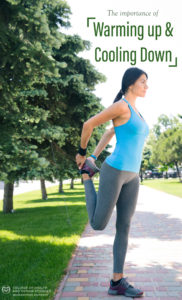Many of us are aware of the recommendations for exercise: 3-5 days a week of moderate to vigorous aerobic activity, and 2-3 non-consecutive days a week of strength training. But are we as aware of warming up and cooling down?
Heading straight into a workout without a warm-up and promptly finishing exercise with no cool down is not the best approach (read: It’s bad, don’t do it). Incorporating a warm-up and cool down is a great way to slowly increase your total time of exercise, decrease the risk of injury, and improve workout performance.
It’s easy to skip these parts of a workout because of time, or thinking we don’t need it, but in reality, it’s recommended to partake in a minimum of 5-10 minutes of a light warm-up along with 5-10 minutes of a cool down. So, what constitutes these portions of a work out?
Warm-up
A warm-up is essentially just the preparation for further exercise at a higher intensity. Warm-ups should be light to moderate in intensity depending on the exercise to follow. There should be a gradual increase in body temperature and incorporation of large muscle groups. This slow increase in heart rate contributes to an increase in circulation, therefore, oxygen and nutrients will be delivered to working muscles. There is also a cognitive benefit to warm-ups, as it provides mental preparation for further exercise.
Warm-up are like priming the pump for exercise. In most instances, it’s of no benefit to go from zero to 60, so start incorporating a warm-up of 5-10 minutes on the bike, treadmill, track, or try some dynamic movements. If going out for a 3-mile run, consider a half mile warm-up before your 3 miles. As we age, our warm-ups should get longer and more gradual. This is also true if our intended exercise is particularly vigorous, or we’re coming back from an injury.
Cool Down
Almost the reverse of a warm-up, this time frame is a period of low impact and slower pace exercise performed after more vigorous exercise. Just like we didn’t want to go from zero to 60, we don’t want to stop immediately. The risk of no to minimal cool downs can cause pooling in the lower extremity and an excessive drop in blood pressure.
Just as we had to prepare for a change in physiological state with the warm-up, we want to provide the opportunity to slowly transition back to a more normal physiological state with a cool down. We’ll see a drop in heart rate and blood pressure to a similar if not lower level than pre-exercise. Along with fully warm muscles this is the best time to incorporate flexibility training, which can often be an overlooked area of fitness. Start the cool down with a less intense version of the same exercise, or a few minutes of walk, then transition into a flexibility portion hitting major muscles groups with about a 10-30 second stretch.
Kimberly Burke is the director of the Adult Fitness Program at Colorado State University, an outreach program through the Department of Health and Exercise Science. Adult Fitness offers exercise opportunities for employees of CSU as well as community members, while providing hands-on learning experiences for health promotion students. To learn more see http://hes.chhs.colostate.edu/outreach/adultfitness/
For more health tips, visit the College of Health and Human Sciences Pinterest Board.